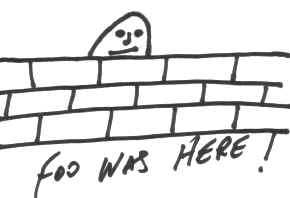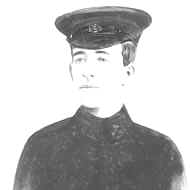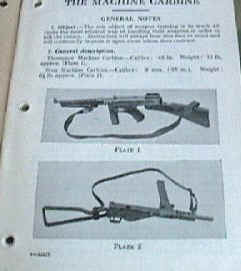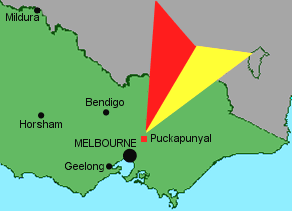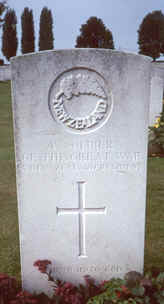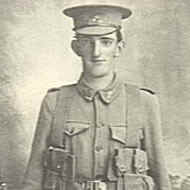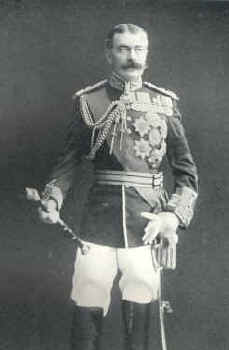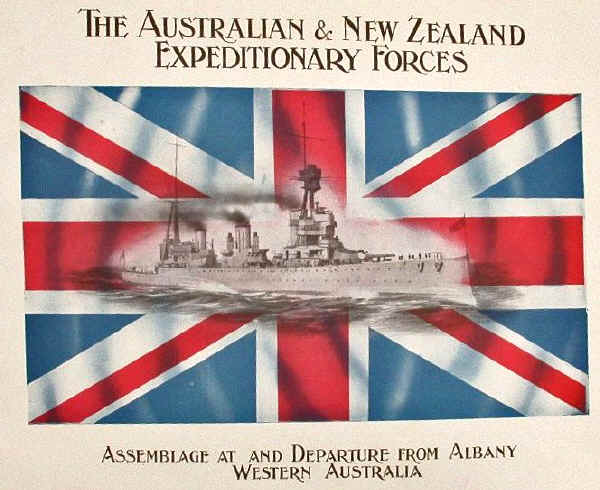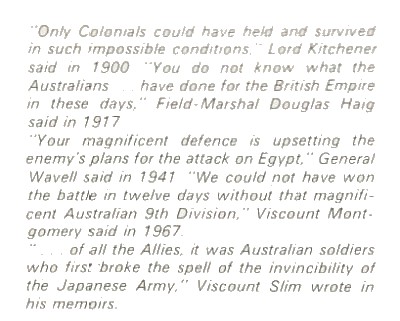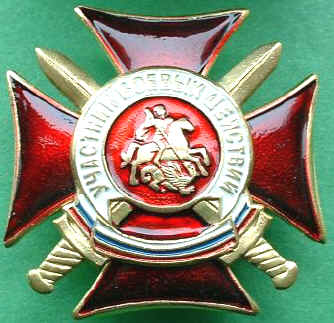 |
|
|||
Who was
"Foo"?
|
| He reappeared in WW2. Later in WW2 (particularly with RAAF) he took on a more devilish appearance. | |
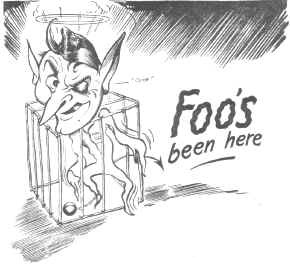 |
Of course we're sure that you once knew A bit of a lad by the name of "Foo". He's the joker who's been on the ramp, And written his name in every camp. But now his scheming's all come to naught, For as you see Foo has been caught. |
|
How he was caught is not quite clear, But it was in a "Waaafery", or there quite near. Ah ! But this is no time to sing and shout For Foo has just this minute got out, And just as one would expect to find, |
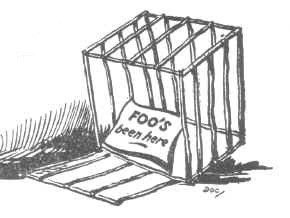 |
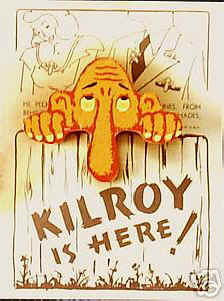 |
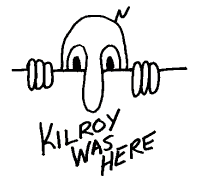
|
| There was one person who led or participated in every combat, training or occupation operation during WW II and the Korean War. This person could always be depended on. GI's began to consider him the "super GI." He was one who always got there first or who was always there when they left. I am, of course, referring to "Kilroy". Somehow, this simple graffiti "Kilroy Was Here" captured the imagination of GI's everywhere they went. The scribbled cartoon face and words showed up everywhere - worldwide. |
|
|||
ALICE pack. Officially (All-purpose Lightweight
Individual Carrying Equipment, previously called webbing). Originally an American
term for the webbing,
"Alice" became common usage in the Australian Army for the
metal frame that carries the equipment a Digger humps through the scrub.
I don't think it was ever an officially recognised term for the metal
frame. |
| Did
soldiers of WW1 believe that it was "the war to end all
wars"?
No. That is a fallacy that started well after the war. H G Wells wrote a book in 1914 called "The war that will end war". It is one of his lesser works and apart from the name is almost forgotten.
US President Woodrow Wilson used the term in a
speech in 1917. It was a term that came into common usage post war and usually in a derogatory
or anti-war sense. |
||
| Did
soldiers of WW1 believe that it was all a bit of a lark and an
adventure?
No. Another fallacy. It is possible (even probable) that the first blokes to join the AIF did so with little understanding of what was to follow and did so with a false impression of quick victory and glory for all. However it is impossible to believe that the later recruits, who having read the casualty lists from Gallipoli, Fromelles and other early battles could have been under any mis-apprehension about the serious nature of the task. They knew what the difficulties were, and the risks. This is indicated by the fact that as the war dragged on and the "butcher's bill" got higher so too was there was a lessening of the numbers of eager recruits. These were the blokes called "Fair Dinkums" because if they enlisted even after seeing the casualty lists they must be "fair dinkum". Sydney Milgate (below) is but one example.
|
| Are
Australians warlike?
No. Can I say to the world that we Australians and our sometimes forgotten trans-Tasman cousins the New Zealanders do not make wars. We are a peace loving pair of nations. We would much rather play cricket or football, go fishing, have a cold beer and a hot steak off the BBQ. Anything but make war. However, once put in a position where
we have to fight we borrow from the 42nd Battalion AIF, their Unit motto
CEDE NULLIS (Yield to none) |
| What
are "Bombay Bloomers"?
This was a nickname for Army issue shorts as worn in tropical postings. The design was based on a British pattern with long and wide legs. The British Army has done many
magnificent things but they are not famous for their fashion sense.
|
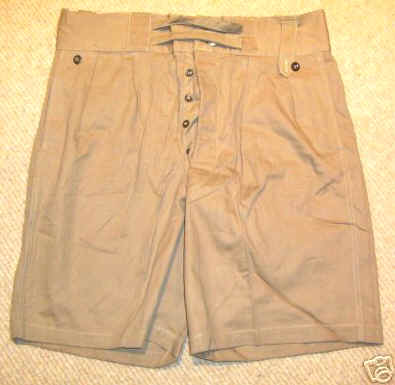 |
| Why
does the army say things backwards?
To avoid confusion. Lets take the slouch hat for example. If you list it as a "khaki fur felt hat" you need to read the entire name before you know that you are talking about a hat and that it should be classified with other hats, not with khakis (or car-keys), furs, or felts. If you list it as a "hat khaki fur felt" it is immediately obvious that you are talking about a hat, that it should be listed and classified with other hats and the less important details follow the main classification. While this might seem pointless in
isolation it is vital when you consider the thousands of items that an
army uses and needs to keep track of. |
| What is the difference between 'machine gun', sub-machine gun and 'machine carbine'? |
| What
is an "automatic rifle"?
A rifle that is capable of reloading
itself after each round and firing another round, automatically.
Originally rifles were 'single shot', that is, manually reloaded after
every shot fired. They were replaced by rifles that were 'self loading'.
That means that after each shot the rifle reloads but does not fire
again until the trigger is depressed again. Automatic is a self loading
rifle that automatically fires another round and continues to do so
automatically while the trigger is
depressed and unused rounds remain in the magazine. |
| What
is a "gas operated rifle"?
Most self loading and automatic weapons are gas operated. They use some of the gas created by the explosion of the propellant in the round to reload the rifle. To do that the gas is used, before the round exits the barrel, to push a spring loaded rod back up a shaft to operate the shell ejection and re-loading mechanism. Some machine carbines use the back
lash from the detonation of the propellant in the round to force the
mechanism back against a spring which then returns it to the firing
position, reloading another round as it does so. This is not
considered gas operated. |
| Where
did the bayonet get it's name?
Bayonets were first used in
Bayonne in 1641. Supposedly, during a battle the soldiers ran out of ammunition,
stuck knives into the muzzles of their guns and charged the enemy. |
||
What
is "Pucka"?
|
| My
Dad served with the P.B.I. I can't find a reference to that Unit. What
was it?
P.B.I is British and Australian Army
slang for "Poor Bloody Infantry". Many, many times over the
years the really dirty jobs, the "last stands", the "Save
The Nation" type jobs are handed to the only people who can do it.
The Infantry. Naval power is wonderful. Air support is great. The Gunners and the
Ginger Beers, the cooks and the cleaners, the suppliers and the
supporters, the planners and power brokers, the politicians and the
pundits all have their place. But when push comes to shove and the
bullets are going both ways, when there is a nasty little (or major) job
on and and
there is some dying to be done ............call up
the Infantry... the poor bloody Infantry. |
In
NZ the poppy is an Anzac Day icon. In Aus it is a Remembrance Day icon.
Why?
In common with veteran's organisations in the United Kingdom, Canada and Australia, the RSA had intended to hold its inaugural Poppy Appeal in association with Armistice Day 1921 (11 November 1921). However, the ship carrying the poppies from France arrived in New Zealand too late for the scheme to be properly publicised prior to Armistice Day, thereby forcing the RSA to postpone its Poppy Campaign until the day prior to ANZAC Day 1922. Thus Poppy Day, as it was immediately known, became uniquely associated with ANZAC Day, whereas in Australia, as with the United Kingdom and Canada, the appeal continued to be associated with Armistice Day (Remembrance Day). In all, 245,059 small poppies were sold for 1 shilling each and 15,157 larger versions of the flower attracted two shillings each, netting the national association, after all expenses, £13,166. Of that sum, £3,695 was sent to French Children's League to help alleviate distress in the war-ravaged areas of Northern France. The remainder was used by the RSA to assist unemployed returned soldiers in need, and their families, during the winter of 1922.
|
| Why
were rifles called 303s?
It was from the size of the bullet
they fired. They were .303 (point three zero three) of 1 inch. By
comparison the 7.62 millimetre rounds used later were .308. For the full
story go to The .303 Rifle including Lee Enfield
|
| If
the Lee Enfield had a "short magazine" what was a "long
magazine"?
This is a common misconception. The word "short" refers to the rifle, not the magazine. To quote an expert........."was unveiled in 1903 as the "Rifle, Short, Magazine, Lee-Enfield, Mark 1", the famous S.M.L.E. It took me quite some time to realise that, with the somewhat awkward, back-to-front nomenclature of British ordnance, the word "short" designation referred to the rifle, not the magazine! Whereas the magazine had the same dimensions as before, the rifle was indeed shorter than its predecessor. The idea was that the S.M.L.E. would be in between rifle and carbine length, and thus serve both functions. Barrel length was now 25 inches, and the robust, bull-dog nose cap/sight protector was introduced. Finally refined as the S.M.L.E. No.1 Mark 3 in 1907, it was lighter and handier than the long Lee-Enfield, was sighted for the new Mark 7 .303 ammunition, had the desired clip feed facility (or "charger loading", as the British termed it) and possessed an excellent set of open sights, which could now be readily zeroed. More details As an associated trivia piece the
bayonet was lengthened by the "lost" 5 inches to retain the
total strike value of the combined rifle/bayonet assembly. |
| What
was K Force?
Korean Force or K-Force. With the
commitment of Australian forces to the Korean War, the Australian
government called for 1,000 men to enlist in the army for three years,
with one year of overseas service in Korea. (Normal enlistment time at
that stage was for 6 years but this was a deterrent to many WW2 veterans
who wanted/needed a shorter term). The term "K-Force"
was primarily a promotional title, as those enlisting became part of the
regular army across all three infantry battalions, and were not a separate
entity. |
| Was
it common to have brothers serve at Gallipoli?
Yes. There was the Curlewis brothers. 4 landed at Gallipoli on April 25th, 3 with the 16th Bn & 1 with the 12th Bn. Only 1 brother survived. Lt Col Malone of the NZEF, the hero of (and KIA at) Chunuk Bair was at Gallipoli and so were two of of his 4 sons. The other two sons (from a second marriage) were too young to serve at that time. Francis Longworth (1st ALH) and his 3 brothers Archibald (6th
ALH),
George (6th ALH) and Hugh (6th ALH) were all there during
October 1915.
At the infamous charge at the Nek, four sets of brothers died. Spare a thought for the Beechey family
of WA in WW1. They sent 8 sons to war, including some to Gallipoli. 5
were killed. 1 was crippled for life. 2 survived intact. Details.
|
Do
you have all the statistics on WW1?
Statistics are notoriously hard
to come by in a way that does not start more arguments than they solve.
ALL statistics are, at best, guesstimates in many cases. Also, different
sets of stats start from different positions. However, I believe these
to be as accurate as can be obtained but I make no guarantees. |
| What is a
Field Marshal's Baton?
It is a short, hand held rank indicator. One might think of it as a swagger stick to the power of 10. AWM REL/04253.001 |
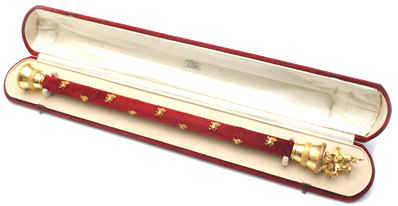 |
| What
is a dixie?
A dixie is either a large Army cooking
pot or saucepan or the set of 2 metal food containers that soldiers
carry to cook food in while in the bush. The word comes from the Hindi
"degci". |
| What
is "dixie bashing"?
It is the army slang term for washing
up. In large army kitchens the plates and cutlery are washed in
automatic dish washing machines but the large pots and pans are still
"dixie bashed". |
|
What were the New Zealand Regimental Numbers of WW1? Service numbers and service person's name might be found on a service persons headstone, death notice in newspaper or on the reverse side of the 1914-1915 Star. A soldier enlisted 17 August 1914 and was at Gallipoli in the NZ Army Medical Corps and his service number was 3/133A. The Army sometimes doubled up on service numbers, so instead of giving out new ones they added the A. When ordering a Service Personnel File include the A otherwise could end up with the service file of the person who had a similar number e.g. 3/133. The following prefixes
were used for WW1 service numbers of troops. Extracted from "Orders,
Decorations and Medals awarded to New Zealanders - an illustrated guide
for collectors" by Geoffrey P. Oldham and Brett Delahunt. |
| What was
"trench fever"?
Trench fever is an unusual disease because it was first discovered in 1915 and reached epidemic proportions on the Western Front, but then suddenly disappeared in 1918 when the war ended. However, during the course of its epidemic, it infected some 800,000 Allied soldiers. It was yet again reported during the 2nd World War, when it affected thousands of German soldiers on the Russian Front, but it is now exceedingly rare. It was caused by a combination of poor living conditions and louse infection. For a full report go to http://www.gwpda.org/medical/liceand.htm
|
| When
did Diggers have a bath in WW1?
On Gallipoli they bathed in the ocean.
In France and Flanders, although Divisional baths (with shared water)
were available in the rear lines, with facilities for bathing and
cleaning of clothes, the goal was only for a bath every 10 days and even
these infrequent baths were not always possible. It must be remembered
that the significance of lice, as the vector of trench fever, was
unknown during the war, and cleanliness was not a priority in the
trenches. This was a major factor contributing to the epidemic of Trench
Fever. |
| I
have heard that soldiers have to shave every day. Is that true?
Yes that is true 99% of the time. In
the Boer War beards were allowed. In WW1 in the trenches shaving was
obligatory if the situation allowed it. WW2 was the same. Shave unless
involved in direct combat. Post WW2 shaving became compulsory regardless of
circumstances. |
| Do
Navy & Air Force have to shave?
Air Force personnel have to shave as
described above. Navy personnel may make application to grow a beard.
If/when granted they are then NOT ALLOWED to shave for a set period. |
The Ode: is it ‘condemn’ or ‘contemn’?Every year, after ANZAC Day and Remembrance Day, the Department of Veterans’ Affairs receives many letters asking about The Ode. The issue raised by most letters is whether the last word of the second line should be ‘condemn’ or ‘contemn’. Contemn means to ‘despise or treat with disregard’, so both words fit the context.
DVA’s Commemorations Branch has been researching the poem and its background. The lines comprise the fourth stanza of the poem For the Fallen by Laurence Binyon, and were written in the bleak early days of World War 1. By mid-September 1914, less than seven weeks after the outbreak of war, the British Expeditionary Force in France had already suffered severe casualties. During this time, long lists of the dead and wounded appeared in British newspapers. It was against this background that Binyon, then the Assistant Keeper of Prints and Drawings at the British Museum, wrote For the Fallen. This poem was first published in The Times on 21 September 1914. The Times shows ‘condemn’. Some people have suggested that the use of "condemn" in The Times was a typographical error. If it were, one would have expected then that the word would be correctly shown in The Winnowing Fan, published only a few months later and for which Binyon would have had galley proofs on which to mark amendments. Binyon was a highly educated man and very precise in his language and use of words. There is no doubt that had he intended "contemn", then it would have been used. There have been variations in punctuation within the poem across the years and a change in the spelling from ‘stanch’ to ‘staunch’. Dr John Hatcher, who published in 1995 an exhaustive biography of Binyon, does not even refer to any possible doubt over condemn/contemn, despite devoting a solid chapter to For the Fallen. The British Society of Authors, who are executors of the Binyon estate, says the word is definitely "condemn", while the British Museum, where Binyon worked, says its memorial stone also shows "condemn". Both expressed surprise when told there had been some debate about the matter in Australia. Interestingly, the text used in 1916 by Sir Edward Elgar to set the poem to music has eight stanzas; the eighth being inserted between what now is regarded as the third and fourth stanzas. The condemn/contemn issue seems to be a distinctly Australian phenomenon. Inquiries with the British, Canadian, and American Legions reveal that none has heard of the debate. Despite an exhaustive search by Commemorations Branch through Binyon’s published anthologies, no copy of the poem using "contemn" was found. The two-volume set Collected Poems, regarded as the definitive version of Binyon’s poems, uses "condemn". Although inquiries are continuing, there now seems little prospect of finding anything to support even a little the "contemn" claim. In Australia, the Returned and Services League, in its League handbook, shows "condemn", while a representative of the Australian War Memorial said it always uses "condemn" in its ceremonies. So how did the confusion start? No-one knows, but certainly the question has been debated for many years. Surely now it’s time to put the matter to rest. |
| What
did entering the army include?
Contract of unlimited liability: Someone who becomes a soldier is crossing a legally defined boundary, giving up some of the individual rights he hitherto enjoyed (such as the right to withdraw his labour), accepting collective standards which contribute to the common good, and undertaking, in the last analysis, to kill or be killed for a purpose in which he may have no personal interest. General Sir John Hackett called this "the contract of unlimited liability". However closely the army may come to resemble society, and however rarely it is called upon to apply lethal force, this essential characteristic still remains. The process of turning a man into a
soldier and the discipline that underpins it has changed over time, and
is complicated by the fact that society, too, is never static, and what
was acceptable this year may not be so next. An age in which men were
deferential, inured to hardship and had low expectations produced raw
material quite different from that in an age where they are
non-deferential, litigious and inclined to question authority. |
| What
is the "short sheeting" my Grandad talks about?
This refers to a joke soldiers play on
each other when they are living in barracks. You strip the victims bed,
hide one sheet and turn the other back on itself at the half-way mark,
and remake the bed. When the victim tries to get in of course his legs
can only go half way down the bed. |
| Does
the army insist that you make your own bed?
I don't know about now as most
soldiers live outside camp in private quarters. When they lived in
barracks the army was VERY concerned with bed making. You were required
to get fresh sheets and pillow cases weekly. The corners of the bed had
to be "hospital corners" i.e. at precisely 45 degrees turn in
and the whole lot had to be so tightly made so as to have a 10 cent coin
bounce if dropped onto it. No bounce?, the inspecting Sergeant would
strip the bed totally and tell you to start again. |
| How
long does it take to dig a trench?
|
| Why
are so many Gallipoli graves "unidentified"?
The
high number of "unidentified" was a result of there
being no opportunity between 1915 and 1919 to preserve the
original timber grave markers and the absence of a Graves Registration
Unit at Gallipoli in 1915. Also creating a problem was the original
non-metal identification disks worn by troops of the British Empire
& Commonwealth. They were pressed fibre and over time they simply
disappeared. |
| Was
Gallipoli mainly an Australian battle?
No. Far from it. Australia and New
Zealand played a significant part but it was smaller than the British
involvement. There were also French, French Foreign Legion, Senegalese,
Indian, Gurkha, Sikh, Punjabi, Maltese, Jewish (Russian & Poles) and
Ceylonese troops or supports. Much of the detail can be had at Graveyards
of Gallipoli, an associate site in the Digger History Group. |
| What
was "a marmalade"?
It was a nick-name for recruits in
WW1. It was given because they were so new that they still enjoyed
marmalade jam. After they had been in the Army long enough to get sick
of the ONLY type of jam offered they were past the recruit stage.
(Cynics say that marmalade jam was the only type offered because all the
apricot jam was sent to Gallipoli, where the troops complained of no
variation). |
| What ships
took part in moving the AIF/NZEF to Egypt?
King George's Sound, WA. 1914-11-01. Departure of the First Detachment of the Australian and New Zealand Imperial Expeditionary Forces from Albany. (AIF & NZEF)
|
| I
have books that say the Anzacs landed at Gaba Tepe. Why do you say
otherwise?
Many books and accounts written at the time and just after refer to the landings at Gaba Tepe (Kabatepe). That is where the Anzacs were supposed to land. That's what the orders said. That is what the troops believed, sometimes for years after the war. In some cases that is what citations for medals said. However, it never happened. It is just another indication of the poor planning and the confusion that bugged the Gallipoli Campaign from the start. The boats either set off from poorly
positioned RN ships, or drifted north or were
steered north (by over a mile) and the landings took place at Ari Burnu
(Anzac Cove and North Beach). Gaba Tepe was never seriously attacked and was the
site of a small but troublesome 4 gun Turkish artillery unit during the entire
campaign. Even 2 months after the landings Field Marshal Kitchener did
not know that the Anzacs were not at Gaba Tepe. |
| What
do other countries think of Australian troops?
|
|
| Is Saint George & the Dragon only associated with English military heraldry? | |
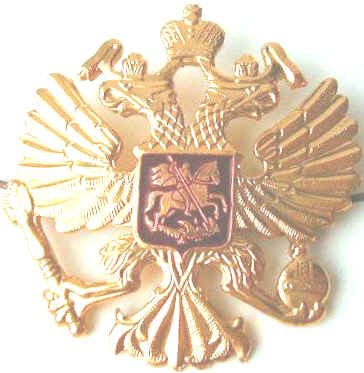 |
No.
The Royal families of many European (and other) countries were
inter-related and they shared many heraldic items.
This Russian Imperial Eagle formal parade visor hat head device insignia- cockade shows that is was not. The Double-Headed Russian State Imperial Eagle Crest Coat of Arms in Gold Color Finish. The Double-headed Eagle was adopted as a Russian Emblem in 1497 by Tsar Ivan III. This Eagle, facing both East and West, was an old Byzantine Emblem of Roman origin. On the eagle breast- ancient Moscow Coat of Arms: St. George slaying The Dragon. |
|
|
This badge was awarded to those who participated in military operations during the Chechen war.The
Russian crest and the image of Saint George Pobedonosets - the
patron saint of
|
|
|
St George was also called on by the Nazis. As the image left shows, they were not adverse to using the English icon for their own purposes. |
| What is a
"horse holder"?
In the Light Horse they were broken up into 3 man sections. (4 men per section if the Regiment was at full strength, which was rarely). When a fight started they would ride to a point nearest the battle, 2 (or 3) would dismount and join the battle and 1 "horse holder" would take care of all 3 (or 4) horses. He would keep them just away from the battle site, close enough to pick up his mates if things went wrong and far enough away to keep the horses safe. Below is an AWM diorama of a horse holder in action at the Battle of Romani, Palestine. |
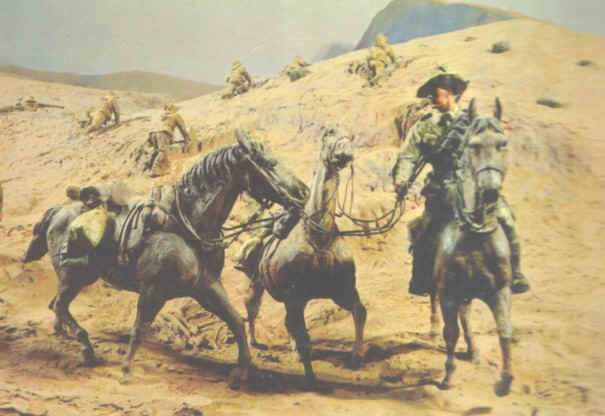
|
| Why isn't
there more NZ stuff on your site
I have as much as I can get. It
might sound strange to Aussies but the Kiwis are a bit "shy"
about their military history. It is almost as if they want to forget
the horrors of war. I quote from the index page of their "Army
Museum" where they say "For many years New Zealanders had
been reluctant to commemorate their military past and as a result
plans for a national war museum had not eventuated. The New Zealand
Army had maintained small collections and displays at Dunedin,
Burnham, Linton and Waiouru. In 1964, a small museum was established
in the original Waiouru Homestead and it wasn't until thirteen years
later that the Chief of General Staff, Major-General Ronald Hassett (a
veteran of WWII and Korea) launched "Operation Heritage" to
develop a national Army Museum.". |
| What
does it mean to "Advance in Review Order"?
This is the most spectacular parade
ground maneuver on the books. The Battalion (600 to 1,000
soldiers) in groups of approx 120 blokes, 40 men of each group
facing the front with 2 behind each man and a band is on parade. The
band will be in the centre. The order is given "band by the centre,
Battalion by the right, quick... The drummers cut in with a tattoo. On
the 9th beat every man steps forward with no further order. He marches
15 paces and comes to a snappy HALT. To see 1,000 men moving as one with
out orders is a sight for sore eyes. |
| Is
it true that a VC winner is to be saluted by all ranks?
No. Some myths have been created over
the years about the "rights" of a VC winner. The most persistent
is that VC winners are to be saluted by all ranks from Field Marshal to
recruit, regardless of the rank of the awardee. Others are that a VC can
"take the parade" and that a VC can "Turn out the
Guard". All are false. They are just part of the fiction that grows
up in soldier's messes. |
| Why
was Germany so keen to have WW2 after the horrors of WW1?
There were several reasons. Reaction to the Great Depression which hit Germany hard, resentment at the huge costs involved with reparations payments forced on Germany by the Allies were two of them. Hitler's megalomania helped as well. One less often recognised component of the German national psyche was the fact that Germany escaped WW1. Yes, she lost hundreds of thousands killed and even more wounded but the war was fought in France and Belgium. French towns were shelled almost to oblivion, German towns were not. French and Belgian citizens were killed in their thousands, German civilians were not. France and Flanders burned, Germany escaped scot-free in that regard. When WW2 came and it was German towns
burning, German cities levelled to the ground, German citizens dying by
the thousand, German women being raped by the Ruskis, German
infrastructure destroyed there was a new found hated of war in Germany.
Invading other countries is fun, being invaded is not fun. Had the
Germans found that out in WW1, WW2 might not have happened. |
| What
is the meaning of "windy" or "Having the wind up?"
The human body naturally reacts to a
scare or fright by evacuating the bladder and bowels. It is called the
"fight or flight" reaction. That is where the saying "had
the shit scared out of him" started. When an upcoming event is
scary the body gets ready to evacuate the bowels by pumping large
amounts of adrenaline into the system. This tends to create gas in the
bowels as part of the attempt to liquefy the excreta to make evacuation
easy. The gas is referred to as "wind" (or farts). So , having the wind
up meant being nervous or scared. Most soldiers, all sensible ones, have
this reaction at some time, usually in the early part of their front
line service. After a while the blokes get conditioned, and the problem
stops (for most people). |
| What
is an "accidental discharge"?
An Accidental discharge (AD) is the
name given to the firing of a rifle accidentally. Soldiers are trained
not to have a live round in the chamber except on active service, while
on operations, but occasionally in training, particularly on rifle
ranges some dill will have an accidental discharge. They are VERY
dangerous and the soldier who has an AD is usually charged and the wrath
of the entire Unit comes down on him. |
| Why
do American junior Officers get gold insignia & seniors get
silver?
Once upon a time army
officers wore gold or silver epaulettes on the shoulders of their
uniforms. On the silver epaulette the rank insignia was in gold
bullion embroidery for contrast and vice-versa for gold epaulettes
with silver rank badges. Generals wore a gold epaulettes with one or
two embroidered silver stars for either Brigadier or Major General. A
full Colonel wore a large silver eagle. Second |
| Which
is correct pronunciation, "Loo-tenant" or "Lef-tenant"?
The correct pronunciation of
Lieutenant in the Australian Services is 'lef-tenant'. The US use the
other version. Strangely the American version is closer to historically
accurate. The word has it's origins in the ranks of the Roman Army and
has come through French and middle English. A 'caput' was the equivalent
a Captain. The word roughly translates to 'leader' or 'head of a group'.
The rank next down would hold 'tenant' (authority) in his absence, or
"in lieu of the tenant". |
| Where did
Australian soldiers serve in WW2?
Australian land forces served in these places.
|
